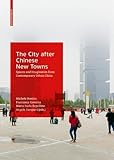The City after Chinese New Towns : Spaces and Imaginaries from Contemporary Urban China / ed. by Francesca Governa, Maria Paola Repellino, Michele Bonino, Angelo Sampieri.
Material type: TextPublisher: Basel : Birkhäuser, [2019]Copyright date: ©2019Description: 1 online resource (240 p.)Content type:
TextPublisher: Basel : Birkhäuser, [2019]Copyright date: ©2019Description: 1 online resource (240 p.)Content type: - 9783035617658
- 9783035617665
- 307.1
- HT147.C6 C587 2019
- online - DeGruyter
| Item type | Current library | Call number | URL | Status | Notes | Barcode | |
|---|---|---|---|---|---|---|---|
 eBook
eBook
|
Biblioteca "Angelicum" Pont. Univ. S.Tommaso d'Aquino Nuvola online | online - DeGruyter (Browse shelf(Opens below)) | Online access | Not for loan (Accesso limitato) | Accesso per gli utenti autorizzati / Access for authorized users | (dgr)9783035617665 |
Frontmatter -- Contents -- Preface -- I. Introduction -- Questioning New Towns -- What Are We Talking about when We Talk about Cities? -- Between the Exceptional and the Ordinary -- What Does a New Town Do? -- About This Book -- Walking Through -- II. Chinese New Towns in Policies, Narratives and Traditions -- A Policy Discourse on New Town Development in Contemporary China -- When Ends Don’t Meet. Historical Interpretations of Twenty-First-Century New Towns -- New Urbanisation and “Go West” Policies -- Shaping Urbanity. Politics and Narratives -- Architecture and New Towns -- The New Towns of Zhaoqing, Zhengdong and Tongzhou -- III. Spaces -- Exhibition Halls -- High-Rise Apartments -- Undergrounds -- Urban Parks -- Mapping New Towns -- IV. Openings -- The City Is Available. Chinese New Towns as a Backup Space -- Scaling Up and Scaling Out. New Towns and “the Standpoint of an Absence” -- References -- About the Authors -- Index of Places -- Illustration Credits
restricted access online access with authorization star
http://purl.org/coar/access_right/c_16ec
By 2020, some 400 Chinese New Towns will have been built, representing an unprecedented urban growth. While some of these massive developments are still empty today, others have been rather successful. The substantial effort on the part of the Chinese government is to absorb up to 250 million people, chiefly migrants from the rural parts of the country. Unlike in Europe and North America, where new towns grew in accordance to the local industries, these new Chinese cities are mostly built to the point of near completion before introducing people. The interdisciplinary publication, written by architects, planners and geographers, explores the new urbanistic phenomenon of the "Chinese New Town". Especially commissioned photographs and maps illustrate many examples of these new settlements.
Im Jahre 2020 soll es 400 „New Towns" in China geben, eine Entwicklung von beispielloser Dimension. Einige dieser Wohnsiedlungen sind heute von fast unheimlichem Leerstand gekennzeichnet, andere aber gelten als gelungene Neugründungen. Ziel der chinesischen Regierung ist es, für bis zu 250 Millionen Menschen Wohnraum zu schaffen, vor allem für Migranten aus den ländlichen Regionen. Während in Europa oder Amerika Städte oft aus kleinen Ansiedlungen organisch wachsen, werden diese "New Towns" komplett fertiggestellt, bevor die ersten Bewohner einziehen. Diese interdisziplinär verfasste Publikation analysiert die "New Town" als neues Phänomen des Städtebaus. Eigens für das Buch entstandene Fotografien sowie neu gezeichnete Pläne dokumentieren beispielhaft solche Großsiedlungen.
Mode of access: Internet via World Wide Web.
In English.
Description based on online resource; title from PDF title page (publisher's Web site, viewed 30. Aug 2021)


